B-hGARP/hTGFB1 mice
| Strain Name |
C57BL/6-Garptm1(GARP)BcgenTGFB1tm1(TGFB1)Bcgen/Bcgen
|
Common Name | B-hGARP/hTGFB1 mice |
| Background | C57BL/6N | Catalog number |
112241 |
|
Related Genes |
GARP(LRRC32,CPPRDD,D11S833E); TGFB1(CED,LAP,DPD1,TGFB,IBDIMDE,TGFbeta,TGF-beta1) |
||
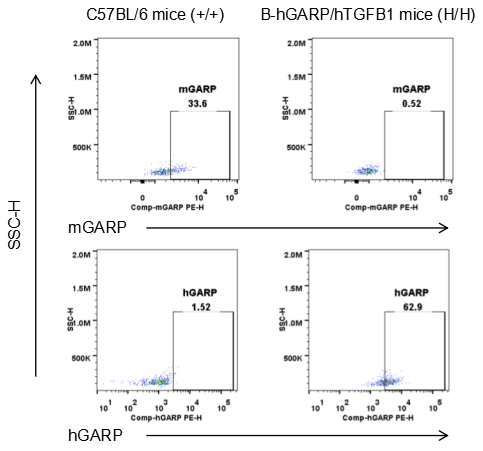
Strain specific GARP expression analysis in wild-type C57BL/6 mice and homozygous B-hGARP/hTGFB1 mice by flow cytometry. Splenocytes were isolated from wild-type C57BL/6 mice and homozygous B-hGARP/hTGFB1 mice. Mouse GARP was detectable in wild-type mice. Human GARP was only detectable in homozygous B-hGARP/hTGFB1 mice.
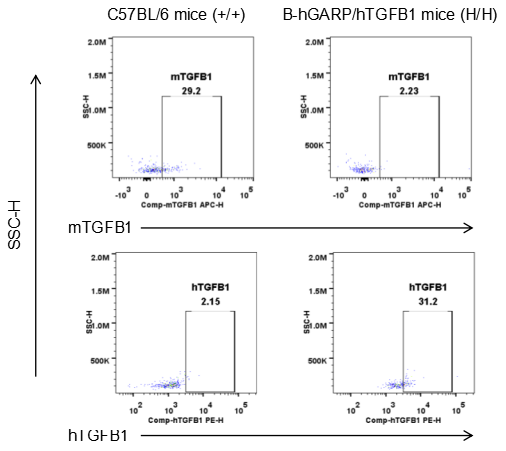
Strain specific TGFB1 expression analysis in wild-type C57BL/6 mice and homozygous B-hGARP/hTGFB1 mice by flow cytometry. Splenocytes were isolated from wild-type C57BL/6 mice and homozygous B-hGARP/hTGFB1 mice. Mouse TGFB1 was detectable in wild-type mice. Human TGFB1 was only detectable in homozygous B-hGARP/hTGFB1 mice.
Protein expression analysis in blood
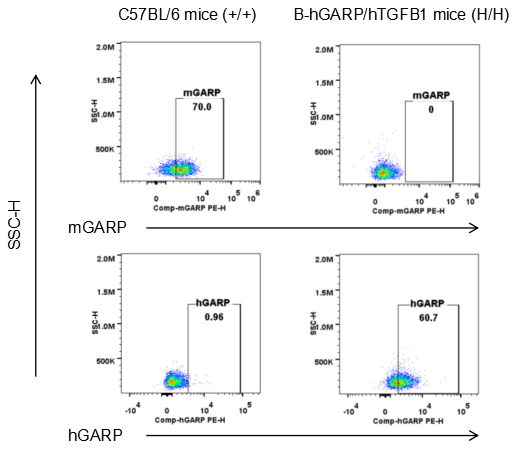
Strain specific GARP expression analysis in wild-type C57BL/6 mice and homozygous B-hGARP/hTGFB1 mice by flow cytometry. Blood were isolated from wild-type C57BL/6 mice and homozygous B-hGARP/hTGFB1 mice. Mouse GARP was detectable in wild-type mice. Human GARP was only detectable in homozygous B-hGARP/hTGFB1 mice.
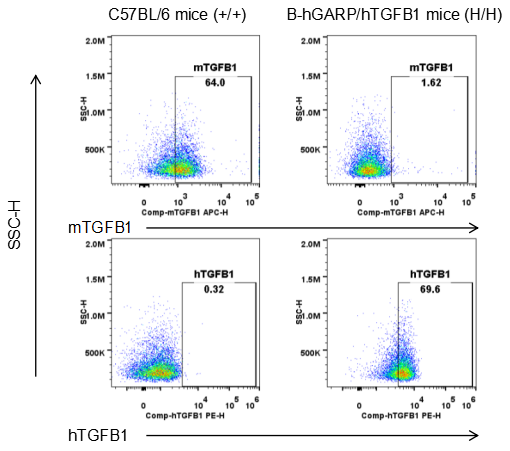
Strain specific TGFB1 expression analysis in wild-type C57BL/6 mice and homozygous B-hGARP/hTGFB1 mice by flow cytometry. Blood were isolated from wild-type C57BL/6 mice and homozygous B-hGARP/hTGFB1 mice. Mouse TGFB1 was detectable in wild-type mice. Human TGFB1 was only detectable in homozygous B-hGARP/hTGFB1 mice.
Analysis of leukocytes cell subpopulation in spleen

Analysis of spleen leukocyte subpopulations by FACS. Splenocytes were collected from WT and homozygous B-hGARP/hTGFB1 mice (n=3, 6-week-old). Flow cytometry analysis of the splenocytes was performed to assess leukocyte subpopulations. A. Representative FACS plots. Single live cells were gated for the CD45+ population and used for further analysis as indicated here. B. Results of FACS analysis. Percent of T cells, B cells, NK cells, dendritic cells, granulocytes, monocytes and macrophages in homozygous B-hGARP/hTGFB1 mice were similar to those in the C57BL/6 mice, demonstrating that introduction of hGARP/hTGFB1 in place of its mouse counterpart does not change the overall development, differentiation or distribution of these cell types in spleen. Values are expressed as mean ± SEM.
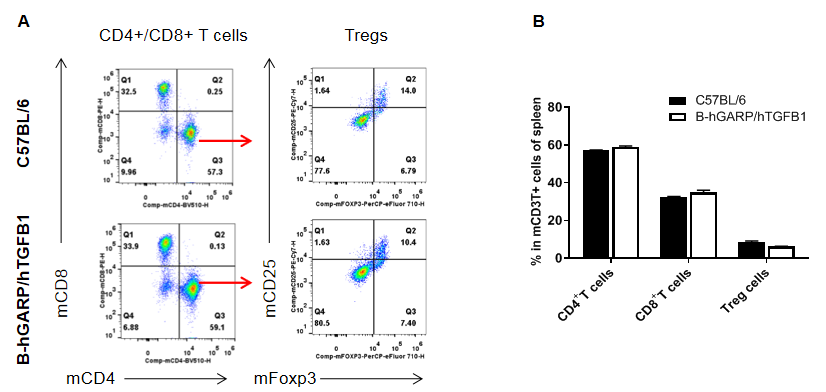
Analysis of spleen T cell subpopulations by FACS. Splenocytes were isolated from female C57BL/6 and homozygous B-hGARP/hTGFB1 mice (n=3, 6-week-old). Flow cytometry analysis of the splenocytes was performed to assess leukocyte subpopulations. A. Representative FACS plots. Single live CD45+ cells were gated for CD3+ T cell population and used for further analysis as indicated here. B. Results of FACS analysis. The percent of CD8+ T cells, CD4+ T cells, and Tregs in homozygous B-hGARP/hTGFB1 mice were similar to those in the C57BL/6 mice, demonstrating that introduction of hGARP/hTGFB1 in place of its mouse counterpart does not change the overall development, differentiation or distribution of these T cell subtypes in spleen. Values are expressed as mean ± SEM.

Analysis of lymph node leukocyte subpopulations by FACS. Leukocytes were collected from WT and homozygous B-hGARP/hTGFB1 mice (n=3, 6-week-old). Flow cytometry analysis of the splenocytes was performed to assess leukocyte subpopulations. A. Representative FACS plots. Single live cells were gated for the CD45+ population and used for further analysis as indicated here. B. Results of FACS analysis. The percent of T cells, B cells and NK cells in homozygous B-hGARP/hTGFB1 mice were similar to those in the C57BL/6 mice, demonstrating that introduction of hGARP/hTGFB1 in place of its mouse counterpart does not change the overall development, differentiation or distribution of these cell types in lymph node. Values are expressed as mean ± SEM.
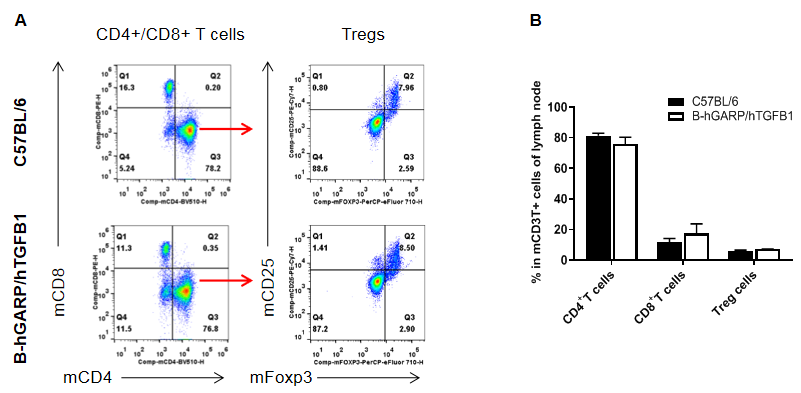
Analysis of lymph node T cell subpopulations by FACS. Leukocytes were isolated from female C57BL/6 and homozygous B-hGARP/hTGFB1 mice (n=3, 6-week-old). Flow cytometry analysis of the splenocytes was performed to assess leukocyte subpopulations. A. Representative FACS plots. Single live CD45+ cells were gated for CD3+ T cell population and used for further analysis as indicated here. B. Results of FACS analysis. The percent of CD8+ T cells, CD4+ T cells, and Tregs in homozygous B-hGARP/hTGFB1 mice were similar to those in the C57BL/6 mice, demonstrating that introduction of hGARP/hTGFB1 in place of its mouse counterpart does not change the overall development, differentiation or distribution of these T cell subtypes in lymph node. Values are expressed as mean ± SEM.

Analysis of blood leukocyte subpopulations by FACS. Blood were collected from WT and homozygous B-hGARP/hTGFB1 mice (n=3, 6-week-old). Flow cytometry analysis of the splenocytes was performed to assess leukocyte subpopulations. A. Representative FACS plots. Single live cells were gated for the CD45+ population and used for further analysis as indicated here. B. Results of FACS analysis. Percent of T cells, B cells, NK cells, dendritic cells, granulocytes, monocytes and macrophages in homozygous B-hGARP/hTGFB1 mice were similar to those in the C57BL/6 mice, demonstrating that introduction of hGARP/hTGFB1 in place of its mouse counterpart does not change the overall development, differentiation or distribution of these cell types in blood. Values are expressed as mean ± SEM.
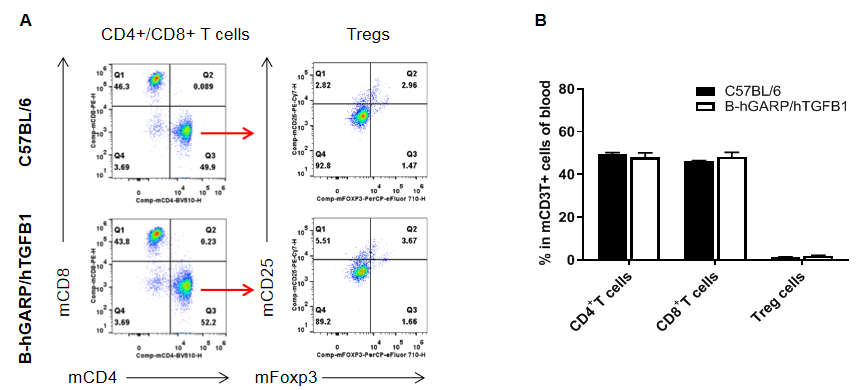
Analysis of blood T cell subpopulations by FACS. Blood were isolated from female C57BL/6 and homozygous B-hGARP/hTGFB1 mice (n=3, 6-week-old). Flow cytometry analysis of the splenocytes was performed to assess leukocyte subpopulations. A. Representative FACS plots. Single live CD45+ cells were gated for CD3+ T cell population and used for further analysis as indicated here. B. Results of FACS analysis. The percent of CD8+ T cells, CD4+ T cells, and Tregs in homozygous B-hGARP/hTGFB1 mice were similar to those in the C57BL/6 mice, demonstrating that introduction of hGARP/hTGFB1 in place of its mouse counterpart does not change the overall development, differentiation or distribution of these T cell subtypes in blood. Values are expressed as mean ± SEM.
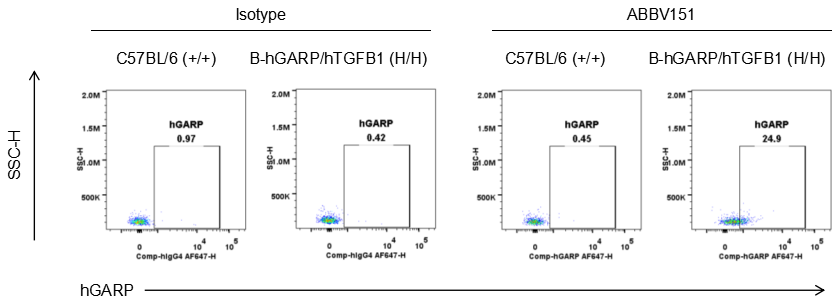
Analysis of splenocytes of B-hGARP/hTGFB1 mice by FACS. Splenocytes were isolated from homozygous B-hGARP/hTGFB1 mice. Flow cytometry analysis of the splenocytes was performed to assess anti-human GARP/latent-TGFB1 antibody ABBV151 (10ug/mL) binding with Tregs. Tregs in homozygous B-hGARP/hTGFB1 mice bind well with ABBV151 vs isotype control.
Combination therapy of anti-mouse PD-1 antibody and anti-human GARP/latent-TGFβ1 antibody
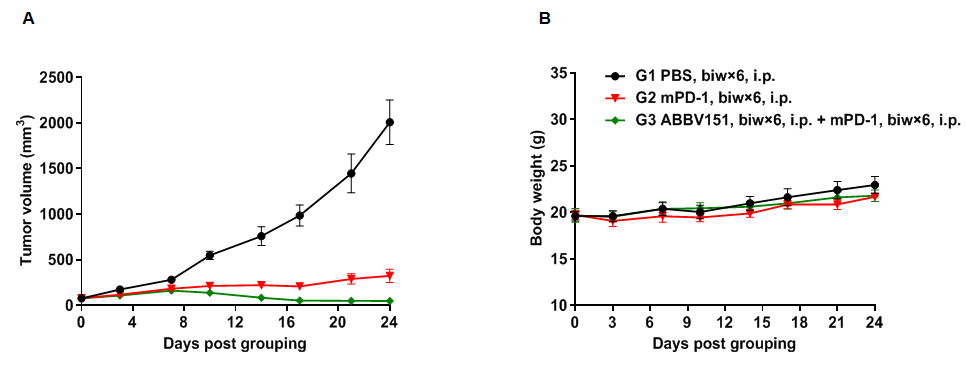
Antitumor activity of anti-mouse PD-1 antibody combined with anti-human GARP/latent-TGFβ1 antibody in B-hGARP/hTGFB1 mice. (A) Anti-mouse PD-1 antibody combined with anti-human GARP/latent-TGFβ1 antibody (in house) inhibited MC38 tumor growth in B-hGARP/hTGFB1 mice. Murine colon cancer MC38 cells (5E5) were subcutaneously implanted into homozygous B-hGARP/hTGFB1 mice (female, 7-week-old, n=6). Mice were grouped when tumor volume reached approximately 50~80 mm3, at which time they were treated with anti-mouse PD-1 antibody and anti-human GARP/latent-TGFβ1 antibody with doses and schedules indicated in panel A. (B) Body weight changes during treatment. As shown in panel A, combination of anti-mPD-1 antibody and anti-human GARP/latent-TGFβ1 antibody were efficacious in controlling tumor growth in B-hGARP/hTGFB1 mice, demonstrating that the B-hGARP/hTGFB1 mice provide a powerful preclinical model for in vivo evaluation of anti-human GARP/latent-TGFβ1 antibodies. Values are expressed as mean ± SEM.








